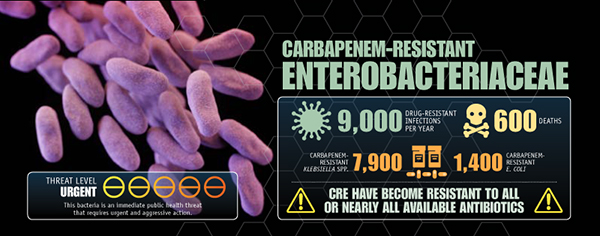
| April 2017 | |||||||||||
| Top stories | |||||||||||
| In the news | |||||||||||
| Photos | |||||||||||
| Contact us | |||||||||||
| Archive | |||||||||||
|
Bacteria resistant to antibiotics placed on reportable list |
April 20, 2017 --
The State Hygienic Laboratory began testing for carbapenem-resistant enterobacteriaceae (CRE) in January, the same month the Iowa Department of Public Health temporarily added CRE-caused infections to the list of reportable diseases in Iowa because of its emerging threat to public health.
 The State Hygienic Laboratory is part of the Antibiotic Resistance Lab Network that tests for and tracks the incidence of antibiotic-resistant bacteria, including one of the most lethal, carbapenem-resistant enterobacteriaceae.
The State Hygienic Laboratory is part of the Antibiotic Resistance Lab Network that tests for and tracks the incidence of antibiotic-resistant bacteria, including one of the most lethal, carbapenem-resistant enterobacteriaceae.
Enterobacteriaceae are a family of bacteria, including Klebsiella species and Escherichia coli (E. coli), which are found in normal human intestines (gut). Sometimes these bacteria can spread outside the gut and cause serious infections, including pneumonia, bloodstream infections, urinary tract infections, wound infections and meningitis.
Carbapenem are a type of antibiotic frequently used to treat severe infections. CRE's resistantance to these antibiotics make them difficult to treat. The CDC reports that they can result in death in up to 50 percent of patients who become infected.
Healthy people usually do not get CRE infections, according to CDC. CRE infections most frequently occur in hospitals, nursing homes and other health care settings. Patients most as risk include those who require devices such as ventilators, urinary catheters or intravenous catheters, and patients who are taking long courses of certain antibiotics.
Since surveillance of CRE began in Iowa, 30 cases have been reported. Of those, four have been identified as possessing a carbapenemase, the enzyme that produces resistance to antibiotics.
Nationwide investigations are ongoing to determine additional risk factors, and to implement infection prevention measures to stop the spread of CRE. More information on CRE is available on the CDC website.

To combat the threat of antibiotic-resistant bacteria which infects two million people a year, CDC launched the Antibiotic Resistance Lab Network (AR Lab Network) in the fall of 2016. All state public health laboratories, including the State Hygienic Laboratory, are part of this network. The AR Lab Network provides infrastructure and lab capacity to detect and support response to resistant organisms recovered from human samples. The Minnesota Department of Public Health is the network's regional lab for the central region, which includes Iowa.
Specimens for testing of carbapenemase should be submitted to the State Hygienic Laboratory for additional testing.